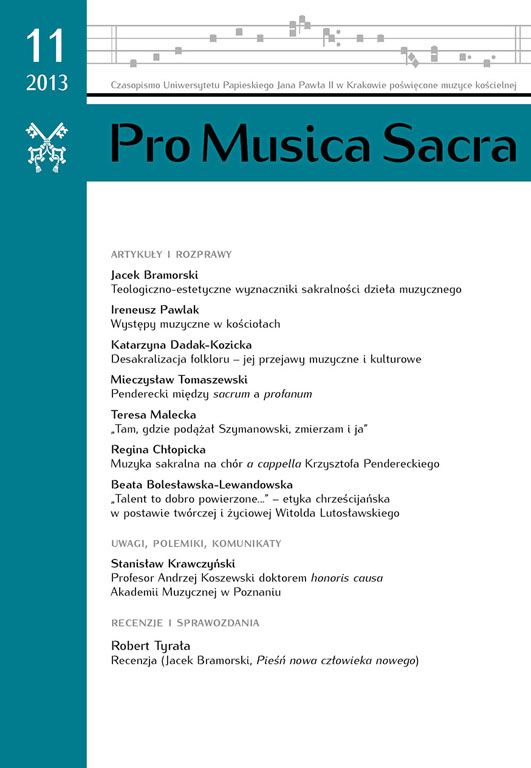The musical and cultural manifestations of desacralisation of folklore
DOI:
https://doi.org/10.15633/pms.555Keywords:
folklore, folk culture, folk songs, folk beliefs, hermeneutics of folklore, mythologization of folkloreAbstract
The religious dimension of traditional culture – crucial to the understanding of the rituals which form a commentary on the cycle of the life of nature (annual rituals) and the life of humankind (family rituals) – is of particular importance, but it is also difficult to research. The ethnologists who documented folklore were sensitive to this aspect of culture (i.e. the suprasensory life) even as early as the eighteenth century, but they did not know how to document it correctly, and imposed their own ideas – e.g., deistic ones – on the mentality and the imagination of the rustic population as revealed in their art. Incomplete (i.e., concerned with selected aspects of culture and art) and not very accurate documentation (searching for folklore’s original versions, e.g., the brothers Grimm) resulted in the creation of standards of fairytales or songs which make reading their content and interpreting their form correctly more difficult today. Yet in folklore the content, the form and the function were organically bound together. This rather inadequate documentation encouraged erroneous interpretations, and even the mythologising of folklore in later periods, Documentation was shaped to fit in with the assumptions and ideas of the researchers, thus falsifying, in particular, the unique character of folk symbolism and poetics, the distinctiveness of folk thinking. In fact, it was not until the nineteenth century that Oskar Kolberg created reasonably full and reliable documentation of folk art – viewed in the context of traditional culture and nature – in his monumental work Lud, jego zwyczaje, sposób życia, mowa, podania, przysłowia, obrzędy, gusła, zabawy, pieśni, muzyka i tańce [People, their customs, way of life, speech, legends, proverbs, rituals, magic, games, songs, music and dances] (1856–1890 – 33 volumes). Ritual folklore, still quite active at that time, reveals both the multifunctionality of forms (associated with the musical and poetic styles), as well as the hierarchical order of functions and values – from the religious, through ethical, aesthetic, cognitive and socialising ones, to the ludic function.
At the same time ritual folklore reveals a tendency towards an increasingly prominent emphasis on the ludic function, at the expense of functions concerned with belief, religion and philosophy. This can be seen in the gradual disappearance of archaic ritual chants with original tonal-melodic patterns, slow tempos and a-metric structure. These chants were a manifestation of a contemplative-reflective attitude towards the world and towards life, regarded as sacred. In the twentieth century, harvest chants represented a relic of this attitude. The unique nature of rustic culture expressed in these chants was investigated by E. JagiełłoŁysiowa (Elementy stylów życia ludności wiejskiej [Elements of lifestyles of the rural population], 1978). She emphasised the changes taking place in the attitudes of peasants towards nature, and in particular towards the nourishing Mother Earth and work on the land; these were losing the religious dimension in favour of an economic approach towards all work, while the ritual celebrations were gradually becoming predominantly a form of entertainment. Replacing the ritual chants with ditties, frequently of a lewd character (at one time these forms complemented each other), is a symptom of the changes – the disappearance of the contemplative-reflective attitude to the life of nature and humankind, the loss of the sacral dimension. The archaic style of chanting thus disappears as well.
Downloads
Published
Issue
Section
License
Copyright (c) 2013 Katarzyna Dadak-Kozicka

This work is licensed under a Creative Commons Attribution 4.0 International License.
Authors who publish with this journal agree to the following terms:
- Authors retain the copyright and full publishing rights without restrictions, and grant the journal right of first publication with the work simultaneously licensed under a Creative Commons Attribution 4.0 International License that allows others to share the work with an acknowledgement of the work's authorship and initial publication in this journal.
- Authors are able to enter into separate, additional contractual arrangements for the non-exclusive distribution of the journal's published version of the work (e.g., post it to an institutional repository or publish it in a book), with an acknowledgement of its initial publication in this journal.
- Authors are permitted and encouraged to post their work online (e.g., in institutional repositories or on their website) prior to and during the submission process, as it can lead to productive exchanges, as well as earlier and greater citation of published work (See The Effect of Open Access).

